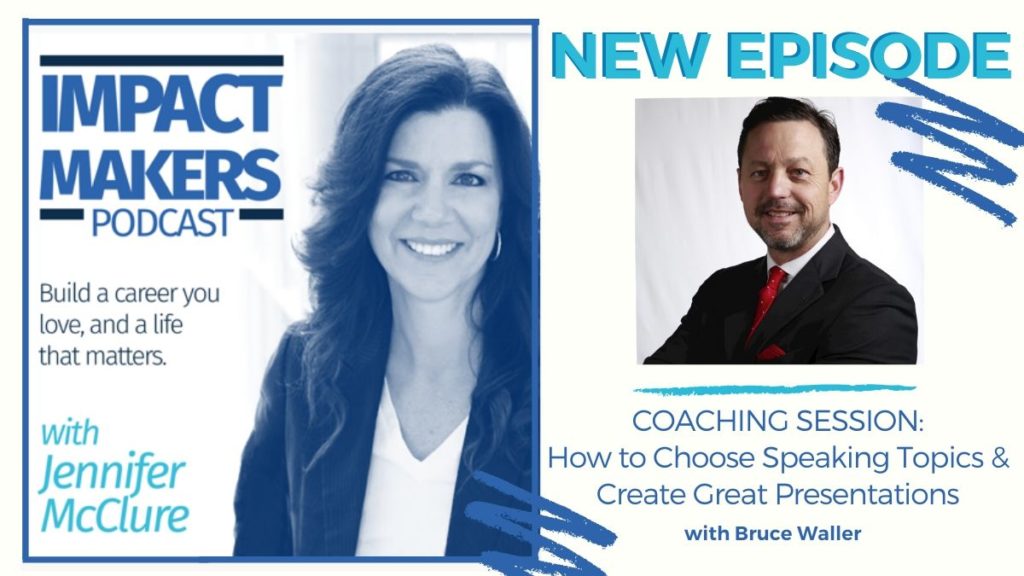
By far, the most frequently asked question I get is “How do I become a speaker?”, or something similar.
And while I’ve written blog posts on the subject, and have been interviewed on other people’s podcasts, and shared about the beginnings of my own journey as a professional speaker in Episode 7 of this podcast, there’s always more to learn, and everyone is at a different place in their speaking career, so I don’t think that I’ve run out of things to say on the subject.
Recently, a good friend of mine – Bruce Waller – reached out to me and asked if he could schedule a call to talk about Speaking. Specifically about how to choose speaking topics, and ideas for creating great presentations and slide decks.
I asked Bruce if he’d be willing to allow me to record our conversation, and share it with you on the Impact Makers podcast. Because it can likely help many people who are either interested in improving their speaking skills as a part of their current job, or who are interested in developing a speaking business either as a side hustle or full-time occupation.
Thankfully, Bruce agreed, and you’ll have the opportunity to learn right along with him in this coaching session. He asked some great questions, and it was lots of fun!
IMPACT MAKERS PODCAST – EPISODE 31
How Do You Decide On Topics For Speaking?
Speak about your area of expertise. Think about what questions people ask you the most.
It’s a good idea to keep a question log, and update it as people ask new questions through emails, messages, tweets, or other conversations. So, when you’re considering the content for a speaking engagement, look at your question log. It’s a great resource for a new speaking engagements, a keynote, a blog post, a book, or other topics. If several people are asking you the same question, you are already being viewed as a person with expertise!
Don’t just try to speak on a hot topic. Instead, plan to speak on something in which you have expertise. One way to identify those areas is to look at the themes of what people are asking you.
What Is The Process For Creating A Presentation?
One thing is to consider is that there are at least three different types of presentations. These are breakouts/seminars in which you’re teaching, workshops in which you’re both teaching and involving the participants, and keynotes which are more story-based, and typically provide inspiration.
To create a presentation, one idea is to start with slides and think about the images you’ll use, as well as the visual flow of the presentation. Ask yourself – what does the audience need to know about the topic? What are the questions people ask about the topic, and what are your answers? Share examples from your own experience, or examples of how others have solved those problems, and end with action steps. Participants typically want to be able to write down some takeaways to plan their next steps.
What Are Some Great Resources For Presentation Images?
When it comes to images for your slides, be careful not to use Google images, or images that are copyrighted, because that could lead to a lot of trouble. The good news is that there are several good sites where you can get free (and copyright-free) images, such as Unsplash or Flickr.
Personally, I use Adobe Stock Images, which is not free, but allows me to license a specific number of images for a monthly fee. To up your speaking game, it will be important to either invest in images, or use to find a good source where you can use copyright-free or creative commons use images. If you notice, big-name keynote speakers typically use a minimal number of slides during their presentations, which usually contain only high-quality images, their own quotes, or statistics from their own research. The focus is on what they’re saying, versus the slides that they use (or don’t).
How Does Someone Get Started As A Speaker?
Take a step back and consider who “your people” are. It’s important to be intentional about your audience, and your message. Who is the audience that you’re targeting, and what is the message that they need. Once you’ve determined that, then look at your relationships and ensure that you’re making connections and building relationships with meeting planners in that industry.
A first step might be to attend the events you’re targeting, and maybe even volunteer to help or support the event organizing team. Once you’ve developed some relationships, and become known by the meeting planner, you can submit ideas to be considered for breakout sessions, panel discussions or workshops in your area of expertise. Make sure that the message that you’re pitching is focused on what the audience needs, versus the story you want to tell. You’re there to serve the audience, not yourself!
More Info And Resources
Thanks to King University, who’s support makes this podcast possible! King is proud to offer sixteen online degrees with accelerated programs and affordable tuition so you can start a new career faster than ever. You can choose from programs in technology, communication, and business – like an online MBA with six concentrations including human resource management. And because the program is offered fully online, you can earn your degree on your own schedule in as little as 16 months. Visit https://online.king.edu/impactmakers to learn more about the King Difference today.
Disclosure: Some of the links in this post are affiliate links, and if you go through them to make a purchase I’ll earn a commission. Keep in mind that I only link to products or companies because of their quality, or my personal experience with them, and not because of any commissions I receive from your purchases.